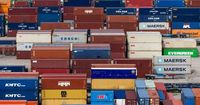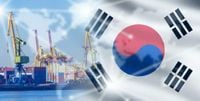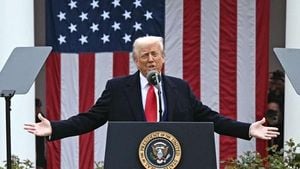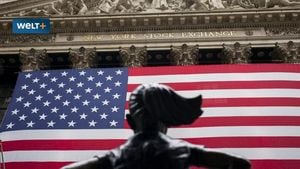South Korea's exports gained momentum in March 2025, providing some relief to policymakers striving to protect the trade-dependent economy from the escalating tariff campaign initiated by President Donald Trump. According to data released by the customs office on April 1, 2025, the value of adjusted shipments rose by 5.5% compared to the previous year. This marks a significant improvement from the initial report of a 5.9% decline for February. However, when accounting for half a working day less compared to the previous year, exports actually grew by only 3.1%, falling short of the anticipated 5.0% increase predicted by Bloomberg economists.
Meanwhile, total imports increased by 2.3%, resulting in a trade surplus of approximately $5 billion. These figures were released just days before the United States was set to announce reciprocal tariffs on imported goods from its trading partners, a key component of Trump's plan to rebalance global trade and bolster U.S. manufacturing.
South Korea is particularly vulnerable to trade protection policies, as its economy heavily relies on foreign demand. Trump's strategy to tighten American tariffs and bring manufacturing back to the U.S. poses a risk to several South Korean firms deeply integrated into global supply chains, including tech giant Samsung and major automakers like Hyundai Motor. The new tariffs are expected to compound existing duties of 25% on steel and aluminum, which were imposed last month, along with additional tariffs on cars that will come into effect this week.
Compounding these challenges, President Yoon Suk-yeol has warned of increasing trade risks at a time when his short-lived martial law declaration in December 2024 has dampened consumer confidence, prompting economists to lower their growth forecasts for the country. Yoon is currently awaiting a court decision that could determine whether he will be ousted or reinstated in office.
As the uncertainty lingers, the South Korean won has depreciated by 2.2% against the dollar over the past month, making it the worst-performing currency in Asia against the U.S. dollar. This decline raises the cost of imports, further straining the economy.
In response to these mounting trade risks, the South Korean government is looking to allocate 10 trillion won (approximately $6.8 billion) in additional spending through a supplementary budget to support recovery efforts in the southern regions recently affected by widespread wildfires. However, the main opposition party, the Democratic Party, has criticized the proposed budget as too small, while the government aims to pass it this month. Bank of Korea Governor Rhee Chang-yong has previously stated that the financial package should ideally range between 15 and 20 trillion won to effectively address the challenges.
In a separate report, South Korea's trade surplus for March 2025 was noted at $4.9 billion, with exports showing growth for the second consecutive month. However, the growth rate fell short of expectations, reflecting the ongoing uncertainties in global trade due to the tariffs imposed by the Trump administration.
According to government data, total exports amounted to $58.24 billion in March, marking a 3.1% increase compared to the same month last year. Imports rose by 2.3% to reach $53.29 billion, contributing to the preliminary trade surplus.
Notably, semiconductor exports surged by 11.9%, marking the highest growth in three months, while automobile exports increased by 1.2%, buoyed by rising sales of hybrid vehicles, despite a decline in electric vehicle sales. Conversely, steel product exports plummeted by 10.6%, the largest drop since June 2024, as South Korea is the fourth largest steel supplier to the U.S., which has imposed a 25% tariff on steel imports.
Looking ahead, analysts, including Choo Kyung-wook from Hana Securities, predict that exports may begin to decline starting in April, especially with the introduction of reciprocal tariffs on cars. "While chip shipments are expected to accelerate, high-quality products still face challenges, and there are discussions about car manufacturers potentially raising prices due to tariffs," he noted.
In light of these developments, South Korean President Han Duck-soo has convened meetings with leaders from major corporations such as Samsung, Hyundai, SK, and LG. He emphasized the government's commitment to collaborating with the private sector to formulate strategic responses to the escalating challenges posed by the global trade environment. "The disruption in the global trade landscape has become a significant threat to our export-driven economy," Han remarked.
Despite the hurdles, there is a glimmer of hope as separate data indicates that factory activity in South Korea contracted in March due to weak domestic demand. However, export orders experienced their largest increase in 14 months, driven by robust demand from the United States and the Asia-Pacific region. Shipments to the U.S. rose by 2.3%, while exports to China fell by 4.1%. In contrast, exports to the European Union increased by 9.8%, and shipments to Southeast Asian countries rose by 9.1%.
As South Korea navigates these turbulent economic waters, the interplay of domestic policies, international tariffs, and global market conditions will continue to shape the outlook for its export-dependent economy.





